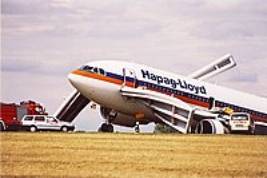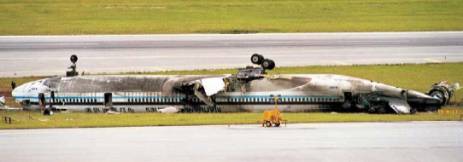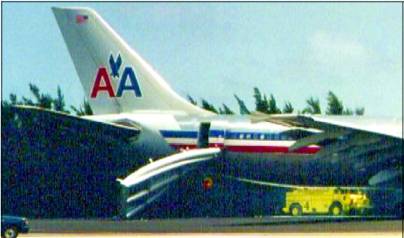Specialized Aircraft Rescue and Fire Fighting Vehicles
The Federal Aviation Administration (FAA) Airport Technology R&D Branch’s Operation of New Large Aircraft (NLA) Research Program is evaluating specialized Aircraft Rescue and Fire Fighting (ARFF) vehicles and equipment that are capable of performing multiple tasks at an aircraft incident. ARFF personnel are required to provide a wide variety of services during both life-threatening and non life-threatening aircraft emergencies. The severity of an aircraft incidents can vary widely from running off the runway to a crash landing involving fire. Aircraft do not always land on level surfaces or orient themselves so that all the emergency exits are usable or easily accessed. Weather can also hinder the use of slides, especially in windy conditions. Other factors, such as malfunction and fire, can render emergency slides unusable. A study conducted by the National Transportation Safety Board from 1997 to 1999, reported that 37% of emergency slides involved in evacuations were not functional during the aircraft incident. The majority of injuries reported as a result of emergency evacuations occurred when passengers had to jump from an exit or off the wing because no evacuation slide was available. Traditional ground ladders used for accessing aircraft can be dangerous to climb, extremely difficult to secure to the airplane, require multiple firefighters to setup and do not always reach the desired aircraft exit. Some airports have structural ladder trucks, sky lifts or air stairs, but these vehicles take time to deploy and were not manufactured for intended ARFF operations. The introduction of NLA presents additional challenges to ARFF personnel. The Airbus A380 was certified to carry up to 873 passenger and crew, with the upper deck exit door over 26 feet off the ground.



Traditionally, ARFF personnel were tasked with providing a safe escape route free of fire while passengers self-evacuated. However, ARFF personnel have been required to assist passengers during the evacuation process if slides do not deploy or are unusable, make rapid entry into an aircraft fuselage to rescue injured or incapacitated passengers that can not self-evacuate, in addition to extinguishing interior fires. Several airports are now acquiring mobile air stairs and modifying them for ARFF use with hand lines, ventilation equipment and fire fighting tools. Some European airports have even acquired customized platform vehicles for rapid firefighter access into aircraft. Ideas being discussed are various air stair designs, scissor lift catering style trucks and modified ARFF vehicles with stairs or ladder that will accommodate all sizes of aircraft, including double deck designs. Some manufactures are willing to construct a specialized platform type vehicle, but lack performance requirements and standards set forth by the FAA before they will commit toward the engineering and manufacturing process of constructing a vehicle.
The FAA has already started research in this area including evaluations of a new 65 foot High Reach Extendable Turrets (HRET) capable of reaching the upper passenger decks of NLA and air stairs equipped with fire fighting capabilities (see Interior Intervention Vehicle Research). In addition to these projects, the FAA is also interested in the following areas:
-
Equipment and tools needed on specialized platform type vehicles for assisting ARFF services during the evacuation process and firefighter access inside aircraft.
- Methodologies to assist during passenger evacuation and enabling firefighters to gain access inside aircraft.
- Specialized platform type vehicle requirements for ARFF services to assist during the aircraft passenger evacuation process and enable firefighters to access inside aircraft of NLA and double-deck aircraft.
- Other uses and benefits that an ARFF service specialized platform type vehicle type can be utilized at an airport.
Mr. Keith Bagot
FAA Technical Center
Operation of NLA Research Program
ANG-E261, Bldg. 296
Atlantic City International Airport, New Jersey, 08405
Contact Project Lead: Keith Bagot, ANG-E261
Photos courtesy of Marcus Weigand and Jerry Yau
Last Update:05/31/12